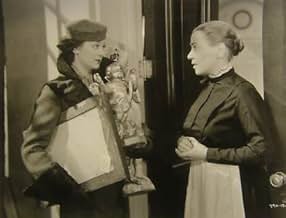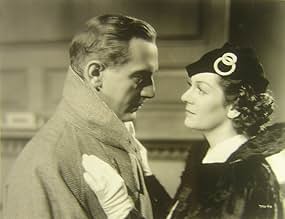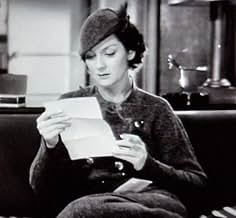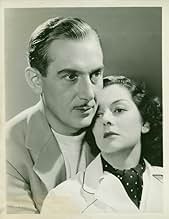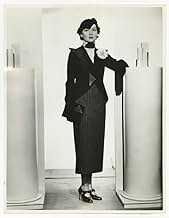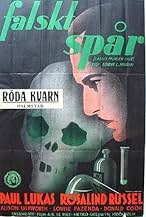Ajouter une intrigue dans votre langueAfter socialite Lynn Llewellyn receives an anonymous threat, he is poisoned at his uncle's casino, and although he recovers, his wife is murdered by the same killer.After socialite Lynn Llewellyn receives an anonymous threat, he is poisoned at his uncle's casino, and although he recovers, his wife is murdered by the same killer.After socialite Lynn Llewellyn receives an anonymous threat, he is poisoned at his uncle's casino, and although he recovers, his wife is murdered by the same killer.
- Réalisation
- Scénario
- Casting principal
Purnell Pratt
- District Attorney John Markham
- (as Purnell B. Pratt)
Leo G. Carroll
- Smith
- (as Leo Carroll)
Ernie Adams
- Husband of Fat Lady at Auction
- (non crédité)
Brooks Benedict
- Casino Patron
- (non crédité)
Edna Bennett
- Nurse to Lynn
- (non crédité)
Sidney Bracey
- Waiter
- (non confirmé)
- (non crédité)
Avis à la une
As good an actor as Paul Lukas is, his accent destroys the illusion that he's the great American detective, Philo Vance, and I was conscious of that throughout. The murder mystery gets off to a good start, but then falters when Vance speculates that perhaps it was "heavy water" that was used as the poison, since it was not known if that substance was poisonous. That idea was pulled out of thin air in an effort to explain why people drinking water would be poisoned. I disliked this development, sensing it was just a plot device to keep the movie rolling, and I was right. He mentions deuterium, Harold Urey's experiments, and the fact a quart of the substance would be worth $100,000, but I'm sure 99% of the 1935 audience didn't know what he was talking about anyway. It would have been much better if he came across Kinkaid's laboratory isolating heavy water by accident and then thought about the possibility of its use as a poison.
But I did enjoy some of the comic relief. William Demarest plays an auctioneer trying to convince people that an ugly statue of cupid was made for Louis XIV, even after his assistant announces it says "made in Japan" on the bottom. In a running gag, Louise Fazenda plays the maid who is caught a dozen times listening at a keyhole and sheepishly says "Did you call, sir," each time. And Charles Sellon is the coroner always complaining about the inconsiderate murder victims getting bumped off just when he's trying to sleep. And there's more comedy too.
But I did enjoy some of the comic relief. William Demarest plays an auctioneer trying to convince people that an ugly statue of cupid was made for Louis XIV, even after his assistant announces it says "made in Japan" on the bottom. In a running gag, Louise Fazenda plays the maid who is caught a dozen times listening at a keyhole and sheepishly says "Did you call, sir," each time. And Charles Sellon is the coroner always complaining about the inconsiderate murder victims getting bumped off just when he's trying to sleep. And there's more comedy too.
Rosalind Russell saves this movie from being just another '30s mystery out of the mystery machine. Paul Lukas, despite his panache is not a good Philo Vance because of his accent. This is more of a romantic "screwball comedy" type of film than a mystery, but taken in that aspect, it's pretty good. The auction scenes and Alison Skipworth are wonderful. The chemistry between the unflappable Russell and Mr. Lukas is really neat, although in the novels romance never got in the way of a good murder. Whether played by Ted Healy or Eugene Palette, poor Sgt. Ernest Heath never got a fair shake. In the books he was never quite the boob portrayed on the screen. The Casino Murder Case is worth viewing if for nothing but to watch Rosalind Russell on top of her game.
One of many films with Philo Vance as the protagonist but the only one with Paul Lukas as the famed detective. He isn't a perfect fit as Vance but does a good job nonetheless.
The real reason to catch this is to get a glimpse of Rosalind Russell early in her career. At this point she was starting to get mired in, as she referred to them, "Lady Mary" roles all dignity, stiff upper lip and little humor. This part hints at the skillful comedienne she was to become. This was only her fifth film but the first where her name appeared above the title a clear sign that the studio had bigger plans for her than to be a leading lady in B pictures.
As for the mystery it's not terribly hard to figure out but it's stylishly shot with a good supporting cast.
The real reason to catch this is to get a glimpse of Rosalind Russell early in her career. At this point she was starting to get mired in, as she referred to them, "Lady Mary" roles all dignity, stiff upper lip and little humor. This part hints at the skillful comedienne she was to become. This was only her fifth film but the first where her name appeared above the title a clear sign that the studio had bigger plans for her than to be a leading lady in B pictures.
As for the mystery it's not terribly hard to figure out but it's stylishly shot with a good supporting cast.
Thus spake Paul Lukas during an uncharacteristic serious moment in this very entertaining, almost light-hearted entry in the Philo Vance canon, this one by MGM.
The play's the thing, right? That's what makes or breaks a movie for most of us - was it a good show or not? This was an excellent murder mystery, a mysterious mystery if you will, and it keeps you guessing until almost the final scene and defies you to figure out the identity of the murderer. There were lots of red herrings and the screenwriters take a few liberties with our credulity, but I thought that, on balance, this was one of the better murder mysteries to come out of Hollywood in the 30's, or any other period for that matter.
William Powell spoiled the Philo Vance character for us. He was so breezy and sophisticated that any other actor would pale in comparison. And Paul Lukas is a pale imitation, to be sure, try as he might. He lacks the suave and cocky air that Powell projected, plus he has an off-putting European accent. But MGM surrounded him with some of the best supporting and character actors available, among them Rosalind Russell, Donald Cook, Isabel Jewell, Eric Blore and the incomparable Allison Skipworth. They also threw in a dance scene at the Casino with "Blue Moon" as background music and with everyone in evening dress. It was, of course, dated but elegant nevertheless.
Remove Lukas and substitute anyone else and this is an 8 rating. As is, I give it a 7.
The play's the thing, right? That's what makes or breaks a movie for most of us - was it a good show or not? This was an excellent murder mystery, a mysterious mystery if you will, and it keeps you guessing until almost the final scene and defies you to figure out the identity of the murderer. There were lots of red herrings and the screenwriters take a few liberties with our credulity, but I thought that, on balance, this was one of the better murder mysteries to come out of Hollywood in the 30's, or any other period for that matter.
William Powell spoiled the Philo Vance character for us. He was so breezy and sophisticated that any other actor would pale in comparison. And Paul Lukas is a pale imitation, to be sure, try as he might. He lacks the suave and cocky air that Powell projected, plus he has an off-putting European accent. But MGM surrounded him with some of the best supporting and character actors available, among them Rosalind Russell, Donald Cook, Isabel Jewell, Eric Blore and the incomparable Allison Skipworth. They also threw in a dance scene at the Casino with "Blue Moon" as background music and with everyone in evening dress. It was, of course, dated but elegant nevertheless.
Remove Lukas and substitute anyone else and this is an 8 rating. As is, I give it a 7.
With a traditional murder-mystery detective plot, clearly written as a pulp novel before being transferred to the screen, this film abounds with idiosyncratic characters and overly dramatic actors. The framing of this mass-consumption plot occasionally leads to heaps of interesting shots, with the traditional benefits of black and white. Intensely-orchestrated scenes of overdone surprise and intruding butlers and maids make the film enjoyable from one moment to the next. Not to mention a delectable performance by Rosalind Russell.
The factors all come together for this film, and if you take it for its backdated surface value, you won't be wasting your time. The trees of this film, so to speak, make a great forest.
The factors all come together for this film, and if you take it for its backdated surface value, you won't be wasting your time. The trees of this film, so to speak, make a great forest.
Le saviez-vous
- AnecdotesSeventh of fifteen films in the "Philo Vance" series released from 1929 to 1947 that began with The Canary Murder Case (1929). The novels by S.S. Van Dine were extremely popular and studios bade for the film rights to each one, making the author very wealthy at the time.
- GaffesWhen Virgina is poisoned, the doctor who examined her states that her pupils were dilated so much that he could barely see the retinas. The retina is a membrane in the back of the eye. He meant that he could barely see the iris. The iris is the colored part of the eye in which the pupil exists. A doctor should have known the difference between the iris and the retina.
- Citations
Philo Vance: Yes, we must discover the wrong direction in order to discover the right.
- ConnexionsFollowed by The Garden Murder Case (1936)
- Bandes originalesSymphonische Dichtung 'Les Préludes'
(1848) (uncredited)
Music by Franz Liszt
Played on a car radio, but morphed into the score
Meilleurs choix
Connectez-vous pour évaluer et suivre la liste de favoris afin de recevoir des recommandations personnalisées
- How long is The Casino Murder Case?Alimenté par Alexa
Détails
- Durée1 heure 22 minutes
- Couleur
- Rapport de forme
- 1.37 : 1
Contribuer à cette page
Suggérer une modification ou ajouter du contenu manquant

Lacune principale
By what name was The Casino Murder Case (1935) officially released in India in English?
Répondre

